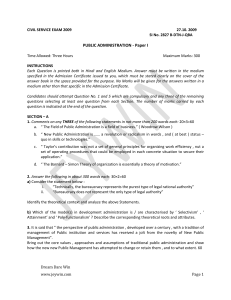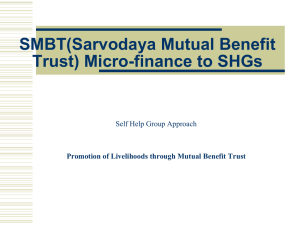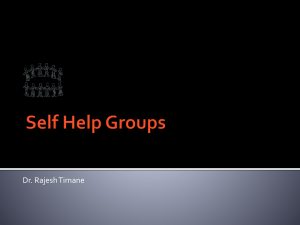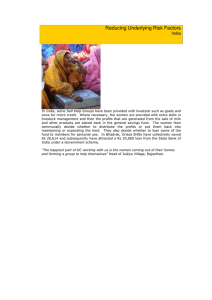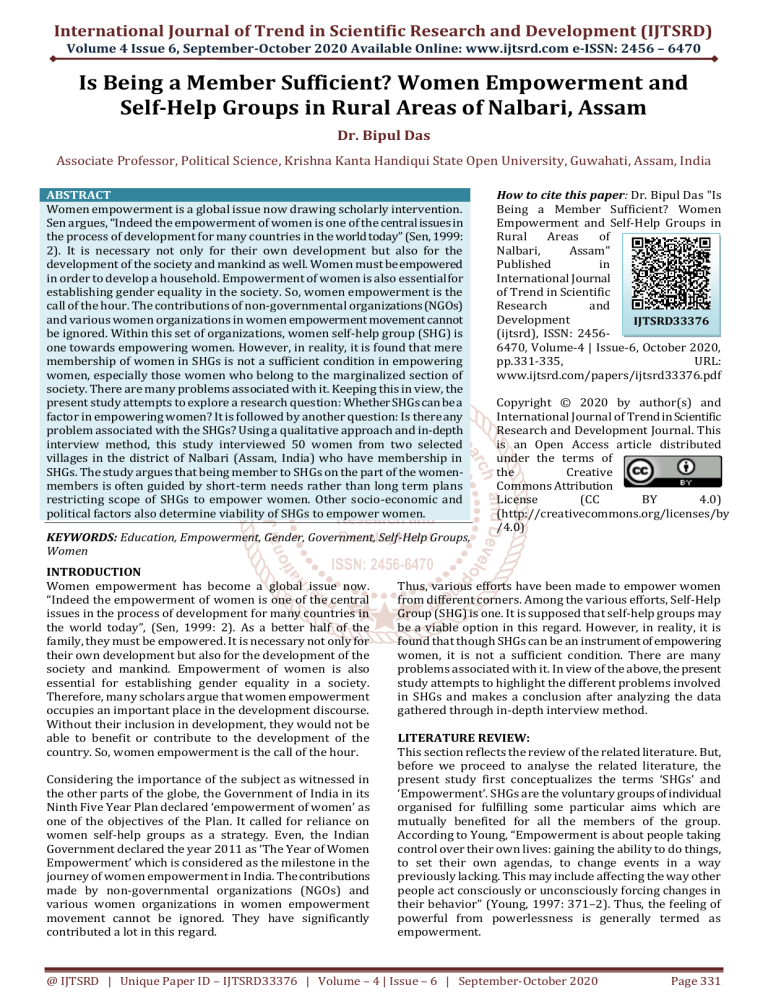
International Journal of Trend in Scientific Research and Development (IJTSRD)
Volume 4 Issue 6, September-October 2020 Available Online: www.ijtsrd.com e-ISSN: 2456 – 6470
Is Being a Member Sufficient? Women Empowerment and
Self-Help Groups in Rural Areas of Nalbari, Assam
Dr. Bipul Das
Associate Professor, Political Science, Krishna Kanta Handiqui State Open University, Guwahati, Assam, India
ABSTRACT
Women empowerment is a global issue now drawing scholarly intervention.
Sen argues, “Indeed the empowerment of women is one of the central issues in
the process of development for many countries in the world today” (Sen, 1999:
2). It is necessary not only for their own development but also for the
development of the society and mankind as well. Women must be empowered
in order to develop a household. Empowerment of women is also essential for
establishing gender equality in the society. So, women empowerment is the
call of the hour. The contributions of non-governmental organizations (NGOs)
and various women organizations in women empowerment movement cannot
be ignored. Within this set of organizations, women self-help group (SHG) is
one towards empowering women. However, in reality, it is found that mere
membership of women in SHGs is not a sufficient condition in empowering
women, especially those women who belong to the marginalized section of
society. There are many problems associated with it. Keeping this in view, the
present study attempts to explore a research question: Whether SHGs can be a
factor in empowering women? It is followed by another question: Is there any
problem associated with the SHGs? Using a qualitative approach and in-depth
interview method, this study interviewed 50 women from two selected
villages in the district of Nalbari (Assam, India) who have membership in
SHGs. The study argues that being member to SHGs on the part of the womenmembers is often guided by short-term needs rather than long term plans
restricting scope of SHGs to empower women. Other socio-economic and
political factors also determine viability of SHGs to empower women.
KEYWORDS: Education, Empowerment, Gender, Government, Self-Help Groups,
Women
INTRODUCTION
Women empowerment has become a global issue now.
“Indeed the empowerment of women is one of the central
issues in the process of development for many countries in
the world today”, (Sen, 1999: 2). As a better half of the
family, they must be empowered. It is necessary not only for
their own development but also for the development of the
society and mankind. Empowerment of women is also
essential for establishing gender equality in a society.
Therefore, many scholars argue that women empowerment
occupies an important place in the development discourse.
Without their inclusion in development, they would not be
able to benefit or contribute to the development of the
country. So, women empowerment is the call of the hour.
Considering the importance of the subject as witnessed in
the other parts of the globe, the Government of India in its
Ninth Five Year Plan declared ‘empowerment of women’ as
one of the objectives of the Plan. It called for reliance on
women self-help groups as a strategy. Even, the Indian
Government declared the year 2011 as ‘The Year of Women
Empowerment’ which is considered as the milestone in the
journey of women empowerment in India. The contributions
made by non-governmental organizations (NGOs) and
various women organizations in women empowerment
movement cannot be ignored. They have significantly
contributed a lot in this regard.
How to cite this paper: Dr. Bipul Das "Is
Being a Member Sufficient? Women
Empowerment and Self-Help Groups in
Rural
Areas
of
Nalbari,
Assam"
Published
in
International Journal
of Trend in Scientific
Research
and
Development
IJTSRD33376
(ijtsrd), ISSN: 24566470, Volume-4 | Issue-6, October 2020,
pp.331-335,
URL:
www.ijtsrd.com/papers/ijtsrd33376.pdf
Copyright © 2020 by author(s) and
International Journal of Trend in Scientific
Research and Development Journal. This
is an Open Access article distributed
under the terms of
the
Creative
Commons Attribution
License
(CC
BY
4.0)
(http://creativecommons.org/licenses/by
/4.0)
Thus, various efforts have been made to empower women
from different corners. Among the various efforts, Self-Help
Group (SHG) is one. It is supposed that self-help groups may
be a viable option in this regard. However, in reality, it is
found that though SHGs can be an instrument of empowering
women, it is not a sufficient condition. There are many
problems associated with it. In view of the above, the present
study attempts to highlight the different problems involved
in SHGs and makes a conclusion after analyzing the data
gathered through in-depth interview method.
LITERATURE REVIEW:
This section reflects the review of the related literature. But,
before we proceed to analyse the related literature, the
present study first conceptualizes the terms ‘SHGs’ and
‘Empowerment’. SHGs are the voluntary groups of individual
organised for fulfilling some particular aims which are
mutually benefited for all the members of the group.
According to Young, “Empowerment is about people taking
control over their own lives: gaining the ability to do things,
to set their own agendas, to change events in a way
previously lacking. This may include affecting the way other
people act consciously or unconsciously forcing changes in
their behavior” (Young, 1997: 371–2). Thus, the feeling of
powerful from powerlessness is generally termed as
empowerment.
@ IJTSRD | Unique Paper ID – IJTSRD33376 | Volume – 4 | Issue – 6 | September-October 2020
Page 331
International Journal of Trend in Scientific Research and Development (IJTSRD) @ www.ijtsrd.com eISSN: 2456-6470
Empowerment has also psychological aspect. According to
some scholars, empowerment refers to a process wherein an
‘individual acquires or strengthens the necessary
psychological resources that will enable goal achievement’
(Amichai-Hamburger et al., 2008: 1777).
participate in, contribute to and benefit from growth
processes on terms which recognize the value of their
contributions, respect their dignity and make it possible for
them to negotiate a fairer distribution of the benefits of
growth’ (Eyben, Kabeer and Cornwall, 2008: 9).
Explaining about empowerment, Kabeer opined, “The notion
of empowerment is inescapably bound up with the condition
of disempowerment and refers to the processes by which
those who have been denied the ability to make choices
acquire such an ability . . . empowerment is about change, it
refers to the expansion of people’s ability to make strategic
life choices in a context where this ability was previously
denied to them” (Kabeer, 1999: 437).
Like economic aspect, gender role is also very crucial in the
empowerment process which signifies the relationship of
power in the society. “Gender is a constitutive element of
social relationships based on perceived differences between
the sexes, and gender is a primary way of signifying
relationships of power” (Scott, 1986: 1067). Similarly, “Since
social institutions are gendered, it is evident that the
economy, the labour market and the political system
generate specific frustrations and opportunities for
mobilisations according to the gender positions occupied. In
addition, since economic and political changes in society all
have the likelihood of being differentiated from a gender
point of view, it must be expected, according to these
occupied positions, that there are objective as well as
subjective variations in the available resources for action but
also in the opportunities, costs and risks of mobilizing
protest” (Fillieule, 2009: 32).
For empowering women, their life styles should be better
which will strengthen their capacity in various aspects of
their life. Therefore, some scholars argued that a better life
for women is essential for women empowerment (McKinsey
and Company, 2010).
Another set of scholars opined that SHGs are argued to be
instrumental for women empowerment, breaking patriarchy
over women (Greaney, Kaboski, and Van Leemput, 2016).
Similarly, SHGs help women strengthen their position in
society and family (Tesoriero, 2006; Acharya et al., 2007).
Some scholars argued that women, by virtue of their active
membership in SHGs, can improve their impoverished
situation (Burra, Deshmukh-Ranadive and Murthy, 2005).
Besides these, SHGs allow collective action of women
opening spaces for effective management of resources on
their part (Agarwal, 2000; Panda, 2007).
Highlighting the importance of SHGs in empowering women
some scholars argue that women involvement in SHGs
makes them experienced to engage in public sphere and this
indicates their freedom beyond domestic sphere (NarayanParker, 2005). It also empowers them in various aspects of
their day to day life.
Defining empowerment, scholars like Rowlands opines that
empowerment is a ‘process whereby women become able to
organize themselves to increase their own self-reliance, to
assert their independent right to make choices and to control
resources which will assist in challenging and eliminating
their own subordination’ (Rowlands, 1997: 17).
Another set of scholars argue that women empowerment
refers to the capacity of women that enables them to access
into resources and materials and means of earning to
improve their own and their family members’ wellbeing and
livelihood (Chant, 2008). Women empowerment requires
appropriate and efficient allocation of resources through
marketisation and government policies (Djelic, 2006).
Economic factors play an important role in the process of
empowerment. Regarding this Minsky remarks, “Economic
issues must become a serious public matter and the subject
of debate if new directions are to be undertaken. Meaningful
reforms cannot be put over by an advisory and
administrative elite that is itself the architect of the existing
situation” (Minsky 1986: 321).
Another set of existing literature argues that ‘economic
empowerment is the capacity of poor women and men to
Peoples’ participation is very important for effective
implementation of the policies and programmes adopted by
the government. It also builds confidence among the people.
Regarding this scholars like Townsend remarks, “The
participation of local people in a project can mean
involvement in all design and implementation, or merely a
show of consultation which is never intended to be allowed
to change anything . . . Similarly empowerment can be used
to describe poor people finding the power to help
themselves, or a government privatising health or pensions
so that it can cut taxes in order to ‘empower’ citizens to
decide whether to spend their income on health or pensions
or conspicuous consumption. It now seems to refer to
promoting entrepreneurial confidence among poor women
rather than any need for the powerful to change, as if the
only problem is the lack of drive among poor women”
(Townsend, 1999: 21).
Some scholars argue that equality of class and sex is very
important for empowering women in the society. They argue
that class inequalities shape lives of women putting them
into the periphery of development (Hopkinson and Aman,
2017). Therefore, “The goal of women’s empowerment is not
just to change hierarchical gender relations but to change all
hierarchical relations in society, class, caste, race, ethnic,
North-South relations” (Townsend, 1999:19).
Another scholar Qian, analyzing the importance of earnings
for empowering women remarks, “One way to reduce excess
female mortality and to increase overall education
investment in children is to increase the relative earnings of
adult women” (Qian, 2008: 1281).
Similarly, Duflo shows that ‘policymakers often are too quick
to conclude that allocation of resources toward women,
rather than men, would always be efficiency enhancing’
(Duflo, 2012: 1075). Again, he argues that that ‘women
leaders do seem to better represent the needs of women’
(Duflo, 2012: 1071).
@ IJTSRD | Unique Paper ID – IJTSRD33376 | Volume – 4 | Issue – 6 | September-October 2020
Page 332
International Journal of Trend in Scientific Research and Development (IJTSRD) @ www.ijtsrd.com eISSN: 2456-6470
From the analysis of the above existing studies, it is evident
that various scholars have forwarded their views regarding
empowerment of women through self-help groups. Many
scholars have argued that it can be one instrument of
empowering women. But, they have not highlighted the
various problems associated with SHGs. Therefore, the
present study aims to highlight the problems in this regard.
OBJECTIVES:
The present study contains the following basic objectives:
A. To assess the role of SHGs in empowering women in
rural areas;
B. To analyse the problems associated with the SHGs for
empowering women in the countryside.
METHODOLOGY OF THE STUDY:
The present study is an empirical one. In-depth interview
method is used here to gather relevant data. “The research
interview is an interview where knowledge is constructed in
the interaction between the interviewer and the
interviewee” (Kvale, 2009). The study is also descriptive and
analytical in nature. It is confined to two revenue villages of
Barkhetri Development Block under Nalbari District, Assam.
The selected villages include Chatemari and Aangradi
Village. The study is also confined to women SHGs
comprising of 10 (ten) women as members. It covered 10
such SHGs. From each of the SHGs having membership
strength of 10 (ten), 5 (five) members (50% of total
members) are selected as sample using simple random
sampling without any social stratification except existing
SHG-membership. Equivalent strength is given in selecting
the size of the sample as they are all the existing members of
a particular SHG. Thus, 50 (fifty) women members are
selected as respondents for the purpose of the present study
and data are drawn after 3 to 4 rounds of interviews and
discussion with the selected women at different times.
CONTEXT OF THE STUDY:
Relative deprivation of entitlements, economic dependence
and lack of education of women compared to men are some
of the obstacles on the way of women empowerment.
Education will empower them in their way of decision
making process. Although SHG is one of the ways of
empowering women, yet it is not a sufficient condition. To
make it sufficient, we need to explore - whether SHGs can be
an empowering strategy?
The present study will contribute to the existing literature
on women empowerment by exploring the grass root level
problems in empowering women through SHGs. The study
argues that SHG is a way of empowering women, but it is not
sufficient one. It is a necessary condition. But at the same
time, we have to emphasis upon some other aspects as well
as the government should also come forward with some
specific policy reforms in this regard. Then only women
empowerment through SHGs will be successful. In other
words, effectiveness of SHGs will come when we will be able
to mitigate the problems associated with it.
FINDINGS AND ANALYSIS:
This section is related with the analysis of the data collected
from the universe. The results and related discussions are
presented in the form of the sub-points mentioned below:
Members’ Objectives: Consumption Vs. Income
Generation: SHGs are formed as a tool for income
generation which also increases the status of the
members. The members with their monthly contribution
as well as government support try to uplift their
economic condition and status. In this regard, the
respondents are asked whether their joining to SHGs
have increased their capacity or status in the society.
Replying to this query, the respondents opined that they
are not in a position to invest more capital for income
generating initiatives and the amount of funds received
from the government is also not sufficient for the same.
So, they use the raised funds for their consumption
purpose. Thus, the study reveals that consumption
tendency is more among the poor women members of
SHGs. They generally want to consume the grants
provided by the government without using it income
generating works. However, among the economically
affluent members, the scenery is different. They try to
enhance their capacity and status by using it properly.
Education and proper knowledge may be important
issues here.
SHG’s Funds and Economy: SHGs and Monthly
Contribution: Existence of every organisation depends
upon the contribution of the members involved with it.
In case of the SHGs, the members contribute their
contribution on weekly or monthly basis. In the present
study, it is found that except three, all the members of
the seven SHGs contribute Rs. 20.00 (twenty) each only
as their monthly contribution which are deposited in
their bank account to enhance their fund. The members
of the other three groups contribute Rs. 100.00 monthly.
Thus, the present study demonstrates that most of the
SHGs are impoverished. As they are not themselves
enriched, so how will they help or protect the interest of
their members? Thus, their poverty and poor economic
condition are standing in their way of empowerment.
Guidance of being members: Self-interest Vs. Others’
Pressure: SHGs are formed among the like-minded
members with some objectives without having any
pressure from others. To know about this aspect, the
respondents are asked whether they have joined
willingly or due to pressure from others. In this regard,
they have commented that due to their self-interest,
they have joined it. Then, the respondents are asked
about the specific purpose of their joining in SHG.
Surprisingly, they are silent in this regard which reveals
that the women members of the SHGs are not aware
about the purpose of their group. It may be due to their
ignorance or dominance and pressure from the male
members of their family. Thus, patriarchy may be an
influencing factor here.
Forming SHGs: Social Vs. Private Interest: Formation
of any organizations or associations is influenced by
some interests which may be social or private. In the
present study, to know the nature and characteristics of
the groups, the respondents are asked about the
purposes of their groups. Here, they have replied in
favour of both social and private interest. They opined
individual development as social development. But, in a
participant observation, it is found in the field study that
more than fifty percent of the respondents have taken
the membership of more than one group. It
demonstrates that they join in various groups to earn
@ IJTSRD | Unique Paper ID – IJTSRD33376 | Volume – 4 | Issue – 6 | September-October 2020
Page 333
International Journal of Trend in Scientific Research and Development (IJTSRD) @ www.ijtsrd.com eISSN: 2456-6470
more income which may be due to their poor economic
condition.
SHGs and Leadership: Conflicting Factors: Leadership
plays an important role in the development of any
organisation. In the present study, it is found that
majority of the SHGs are working smoothly as per their
objectives. However, a few of them i.e. 3 (three) out of
10 (ten) have witnessed their concern over leadership
conflict. The respondents have commented during field
survey that due to the conflict of interests among the top
level office bearers, they are facing problems in fulfilling
their desired goals. Thus, it is revealed that some of the
SHGs have been facing the problems of leadership
conflict which hampers their functioning in general and
social interest in particular. In other words, it may
increase social distancing which hampers the durability
of the SHGs.
Question of Sustainability: SHGs and Durability:
Durability is another aspect associated with SHGs. Every
organisation in order to develop properly must be
durable for long time. As mentioned above, due to the
conflicts of interest among the top level office bearers, it
is seen in the present study that a good portion of the
SHGs are not working properly. It is also found in the
study that some SHGs are formed to fulfill short term
goals. In other words, it is formed for fulfilling personal
gain only. Besides, there are no clear cut objectives as
well as rules and regulations of the SHGs which allow
free entry and exit of the members. It also helps them to
take multiple memberships in different groups.
Therefore, the present study argues that there must
have specific and concrete rules and regulations of the
SHGs in the form of constitution specifying the tenure of
the members and other office bearers.
What Influences? SHGs and Influencing Factor of
Participation: There are various factors which may
influence one to join and participate in SHG. These may
be income generation, social status, power and many
more. Here, to know the pattern of women involvement
in SHGs, the respondents are asked about the factors
that influence them to join in SHGs. The respondents had
replied in multiple ways like- enhancement of income,
power, status etc. Regarding pattern of involvement of
the members, it is found that these groups are formed
among the relatives, and portfolios of the top office
bearers are kept among themselves. It may be a
disappointing factor for those members who have no
blood relation with them. Thus the study demonstrates
that kinship plays an important role in forming these
groups and their decision making process which may be
a threat to social capital. In other words, SHGs may
strengthen social bonding as well as may be a threat to
social bonding.
Beyond Members: SHGs, Bureaucracy and Political
Angle: Bureaucracy plays an important role in an
administration. They implement various schemes and
policies of the government. Therefore, attempts are
made to know their role in implementing various
schemes relating to SHGs. However, in this regard, the
respondents have given a negative picture. They opined
that the bureaucrats created red-tapism in the name of
administration. Some of the respondents even did not
hesitate to say that they were interconnected with the
political leaders. Thus, the study reveals that there is a
nexus between the bureaucrats and the political leaders
which politicized the administrative machinery in the
name of welfare and development.
The Helping Hand? SHGs and Government Support:
The support of the government is unavoidable for the
development of various schemes launched by the
government which is also not exception in case of the
SHGs. It is found in the present study that in spite of
providing various schemes like weaving, goat farming,
broiler farming, duck farming etc. the sample SHGs have
become unable to survive their farms. It may be due to
the lack of knowledge or proper training in this regard.
This reveals the gap between the government policies
and the expectations of the members. Of course, there
may be a political agenda or creation of beneficiaries for
the benefit of the government. Similarly, women are
more likely to be the members of SHGs which may be a
political trend or political patronage where women are
highlighted. They are targeted as beneficiaries and
government announces more benefit to the women
SHGs. Thus, the study argues the feminization of the
SHGs. However, it shows another aspect that women are
not interested in SHGs but they are pushed by the male
members of their family as well as society for getting
benefit.
Motive of Earning More? SHGs and Expectation for
Easy Money: Expectation for money is quite natural; but
expectation for easy money is harmful for all. As we
have mentioned above, in spite of getting various
government funds with ample subsidies, the sample
SHGs under study have failed to develop or even survive.
They are using this platform only for their personal gain
that may be in the form of money or materials. They are
not willing to work hard and they have no work culture.
They are engaged and expecting for easy money only.
Thus, the present study demonstrates that expectation
for easy money, lack of training and work culture have
stood on the way of developing and empowering women
through SHGs.
From the above findings, we may say that there are various
problems associated with the functioning of the SHGs for
empowering women. In this regard, as a universal solvent,
education may play an important role. Besides, massive
awareness programmes, government support with more
subsidies in various schemes like- weaving, cottage
industries, farming etc. and finally willingness to work hard
are the key aspects in this regard.
RECOMMENDATIONS:
From the findings and analysis of the present study, we may
forward the following recommendations:
A. Strong awareness programme with adequate training
should be organized for the members of the SHGs in
their area of specialisation.
B. SHGs should be encouraged for making innovative
products with the help of locally available materials.
C. Government should make a strong mechanism for
monitoring the activities of the SHGs.
@ IJTSRD | Unique Paper ID – IJTSRD33376 | Volume – 4 | Issue – 6 | September-October 2020
Page 334
International Journal of Trend in Scientific Research and Development (IJTSRD) @ www.ijtsrd.com eISSN: 2456-6470
D. There should be provision for financial help through
banks and other financial institutions under strict
supervision of the government.
E. Government, banks and NGOs should come forward with
an integrated approach which will be helpful for
effective functioning of the SHGs.
CONCLUSION:
From the analysis and findings of the present study, we may
say that in spite of various efforts for empowering women
through SHGs, they are not empowered as targeted. As we
have discussed above, it is because of different problems
associated with this. Women empowerment through SHGs is
possible and it can be a necessary condition. But, it is not
sufficient for empowering women because of lots of issues
involved with it. These issues are highlighted in the study.
After mitigating these problems, if we may involve women,
then only SHGs will be an effective instrument for women
empowerment. Besides these, the government, NGOs and the
civil society should come forward in this regard. Then only
the women section associated with this sector will be able to
empower themselves in real sense of the term
‘empowerment’.
References
[1] S. Acharya, E. Yoshino, M. Jimba, and S. Wakai.
“Empowering rural women through a community
development approach in Nepal.” Community
Development Journal Vol. 42 (1), 2007, pp. 34–46.
[2] B. Agarwal. “Conceptualising environmental collective
action: why gender matters.” Cambridge Journal of
Economics, Vol. 24 (3), 2000, pp. 283–310.
[3] Y. Amichai-Hamburger, K. Y. McKenna & S. A. Tal. “Eempowerment: empowerment by the internet.”
Computers in Human Behavior, Vol. 24(5), 2008, pp.
1776–1789.
[4] N. Burra, J. Deshmukh-Ranadive, and R. K. Murthy, eds..
“Micro-credit, poverty and empowerment: linking the
triad.” New Delhi: Sage, 2005.
[5] S. Chant. “The ‘feminisation of poverty’ and the
‘feminisation’ of anti-poverty programmes: Room for
revision?” The Journal of Development Studies, Vol.
44(2), 2008, pp. 165–197.
[6] M. -L. Djelic. “Marketization: from intellectual agenda
to global policy making.” In M.-L. Djelic and K. SahlinAndersson (Eds.), Transnational governance
Cambridge: Cambridge University Press, 2006, pp. 5373.
[7] E. Duflo. “Women empowerment and economic
development.” Journal of Economic Literature, Vol.
50(4), pp. 1051–79.
[8] R. Eyben, N. Kabeer, and A. Cornwall. “Conceptualising
empowerment and the implications for pro-poor
growth." A paper for the DAC Poverty Network, 2008.
[9] O. Fillieule. “Travail militant, action collective et
rapports de genre.” In Le sexedumilitantisme, edited by
O. Fillieule, and P. Roux, 2009, pp. 23–72. Paris: Presses
de Sciences Po.
[10] B. P. Greaney, J. P. Kaboski, and E. Van Leemput. “Can
self-help groups really be ‘self-help’?” The Review of
Economic Studies, Vol. 83 (4), 2016, pp. 1614–1644.
[11] G. Hopkinson and A. Aman. “Women entrepreneurs:
how power operates in bottom of the pyramidmarketing discourse.” Marketing Theory, Vol. 17(3),
2017, pp. 305–321.
[12] N. Kabeer. “Measurement of women’s empowerment.
development and change”. Vol. 30(1), 1999, pp. 435–
64.
[13] S. Kvale. “Doing interviews”. London: Sage publications,
2009.
[14] McKinsey & Company. “The business of empowering
women.” London: McKinsey & Company, 2010.
[15] H. Minsky. “Stabilising an unstable economy”. New
Haven: Yale University Press, 1986.
[16] D. Narayan-Parker, ed. “Measuring empowerment:
cross-disciplinary perspectives.” Washington, DC: The
World Bank, 2005.
[17] S. M. Panda. “Women’s collective action and sustainable
water management: case of SEWA’s water campaign in
Gujarat, India.” CAPRi Working Paper no. 61.
Washington, DC: IFPRI, 2007.
[18] N. Qian. “Missing women and the price of tea in China:
the effect of sex-specific earnings on sex imbalance.”
Quarterly Journal of Economics Vol. 123(3), 2008, pp.
1251–85.
[19] J. Rowlands. “Questioning empowerment.” Oxford:
Oxfam, 1997.
[20] J. W. Scott. “Gender: a useful category of historical
analysis.” The American Historical Review Vol. 91 (5),
1986, pp. 1053–1075.
[21] A. Sen. “Development as freedom.” New Delhi: Oxford
University Press, 1999, p. 2
[22] F. Tesoriero. “Strengthening communities through
women’s self-help groups in South India.” Community
Development Journal 41 (3), 2006, pp. 321–333.
[23] JG Townsend. “Empowerment matters: understanding
power.” In Townsend, JG, Zapata, E, Rowlands, J,
Alberti, P and Mercado, M (Eds), Women and power.
London: Zed, 1999.
[24] K. Young. “Gender and development.” In Visvanathan,
N, Duggan, L, Nisonoff, L and Wiegersma, N (Eds), The
women, gender and development reader. London: Zed,
1997.
@ IJTSRD | Unique Paper ID – IJTSRD33376 | Volume – 4 | Issue – 6 | September-October 2020
Page 335

